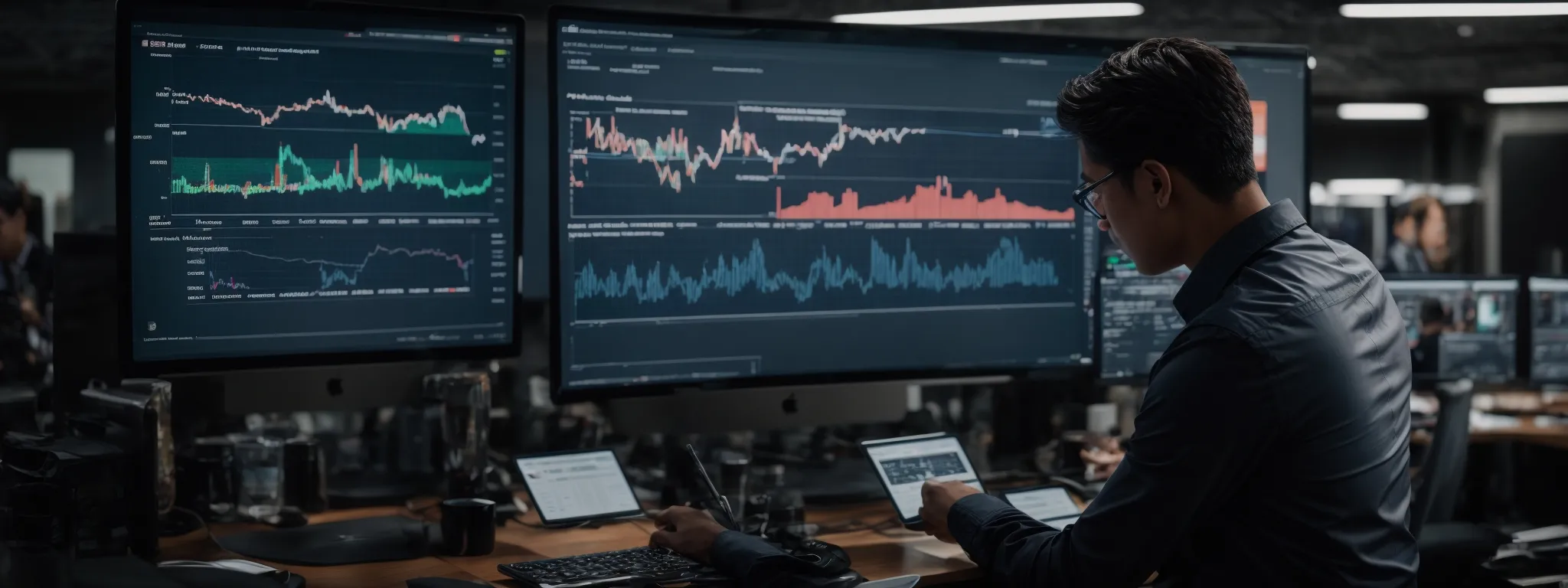Trends in Marketing Budgets
Evolving Strategies for Marketing Budget Allocation As the marketing landscape transforms, chief marketing officers (CMOs) and marketing teams face the challenge of optimizing their marketing budget allocations […]
Evolving Strategies for Marketing Budget Allocation
As the marketing landscape transforms, chief marketing officers (CMOs) and marketing teams face the challenge of optimizing their marketing budget allocations amidst rapid digital acceleration.
The interplay between traditional methods and emerging digital channels requires a nuanced approach, balancing the efficiency of digital platforms with the broad reach of legacy media.
With consumer patterns shifting and digital capabilities expanding, the allocation of marketing spend is more dynamic, reliant on the insights derived from robust marketing analytics than ever before.
Navigating this terrain, industry leaders are adopting agile methodologies to ensure they stay ahead of market trends and maintain a competitive edge.
Keep reading to discover how to future-proof marketing investments in this fluctuating digital marketplace.
Key Takeaways
- Marketers Must Strategically Allocate Digital Marketing Budgets to Balance Effectiveness and ROI
- Tools Like LinkGraph and SearchAtlas Enable Real-Time Optimization of SEO and PPC Strategies
- Traditional Media Still Plays a Significant Role but Must Be Integrated With Digital Campaigns
- Agile Methodologies and Continuous Learning Are Essential for Adapting to Dynamic Market Conditions
- Understanding and Responding to Consumer Behavior Is Crucial for Effective Marketing Budget Allocation
Analyzing the Shift to Digital Marketing Budgets

In an era where the digital ecosystem drives both conversations and conversions, marketing leaders are constantly faced with the pressing necessity to reassess where and how they allocate their marketing budgets.
Recognizing the multifaceted nature of today’s digital marketing landscape, these professionals must judiciously distribute resources between burgeoning platforms and evergreen strategies to fuel growth and captivate their target audience.
As such, understanding how to navigate through social media channels, prioritize search engine optimization (SEO) efforts, embrace the innovations in digital advertisements, and leverage the power of marketing automation becomes essential.
This delicate balancing act not only ensures the effective deployment of marketing spend but also sets a robust foundation for a company to thrive amidst market trends and consumer behavior shifts.
Understanding the Digital Marketing Landscape
In the pulsating heart of the digital marketing realm, brands confront an array of channels, each clamoring for attention and promising unparalleled reach. With advancements accelerating and algorithms evolving, it’s imperative for marketing professionals to deploy tactics that not only resonate with their intended audience but also complement the idiosyncrasies of each platform.
Equipping oneself with the right mix of tools and strategies is tantamount to navigating the complex topography of digital terrain. Marketers are increasingly turning to Sophisticated Solutions Like LinkGraph and SearchAtlas SEO platform, which offer a comprehensive suite of digital PR services, actionable PPC Google Ads strategies, and robust keyword research tools to enhance their marketing effectiveness.
Allocating Budgets for Social Media and SEO
In times of economic flux such as during a recession or in the aftermath of events like the pandemic, chief marketing officers (CMOs) and marketing teams face the imperative task of reassessing budget allocation for maximum impact. The trend has unmistakably shifted towards bolstering digital assets, with a particular emphasis on enhancing social media marketing and SEO – areas proven to drive meaningful engagement and sustained inbound marketing success.
With this shift, the utilization of tools such as the SearchAtlas SEO platform becomes a cornerstone of a digital marketer’s strategy, enabling a meticulous approach to budget allocation. By harnessing the platform’s capabilities, from SEO content assistant to LinkGraph’s cutting-edge link building services, marketing leaders can optimize their social media and SEO investments – ensuring that each marketing dollar contributes to achieving the company’s strategic objectives and staying ahead of the competition.
Adapting to Evolving Digital Advertising Platforms
Marketing teams, faced with the challenge of keeping pace with rapidly changing digital advertising platforms, must stay informed and agile. Adaptability is key, as platforms like Amazon PPC ads, along with social media giants, constantly modify algorithms and introduce new features that can impact campaign performance and marketing spend effectiveness.
To navigate these ever-shifting waters, savvy marketers employ robust tools like LinkGraph and SearchAtlas, which are designed to inform PPC Google Ads strategies and monitor SEO reputation management. Such resources empower organizations to refine and tweak digital advertising efforts in real-time, ensuring that they capitalize on trends and maintain competitive edge.
Investing in Marketing Automation Tools
Investing in marketing automation tools has become a pivotal aspect of digital marketing strategy as it bolsters efficiency and personalization. Marketing automation streamlines lead generation, customer segmentation, and email marketing efforts, allowing marketing teams to focus on creative and strategic tasks that drive consumer engagement and revenue.
By implementing these tools, organizations can tightly align their marketing strategies with business goals and customer expectations, effectively increasing the ROI from their digital marketing budget. The Capabilities Offered by Marketing Automation are indispensable for companies aiming to maintain relevance and personal touch in their interactions with diverse geographies and audience segments.
Balancing Between Traditional and Modern Budget Strategies

As marketing leaders advance their crusade against the tides of change, they encounter a pivotal decision-making process steeped within the age-old debate: the dichotomy between traditional media and the ever-expanding digital marketing frontier.
The evolution of consumer behavior, alongside the advent of innovative marketing technologies, necessitates a nuanced approach to marketing budget allocation.
Embracing a strategy that assesses the relevance of traditional media, strategically integrates it with robust digital campaigns, and meticulously measures the outcomes of both domains is fast becoming a prerequisite for success.
Navigating this confluence can help organizations enrich their marketing strategy, enhance their audience reach, and optimize the calibration of their marketing spend.
Evaluating the Role of Traditional Media Today
In an age where digital channels dominate consumer attention, the role of traditional media in a contemporary marketing strategy remains significant. Although digital avenues offer measurable analytics and targeted outreach, traditional media such as television, radio, and print continue to have a seminal impact on certain demographics and can build widespread brand awareness.
For businesses keen on nurturing a diverse and inclusive audience, the integration of traditional media into the marketing mix can lend credibility and provide a tangible presence in the consumer’s world. It’s about crafting a complementary relationship where traditional media lays the groundwork, and digital strategies capitalize on the engagement:
- Identify the audience segments most influenced by traditional media.
- Measure the reach and persuasive power of traditional avenues with rigorous analytics.
- Strategize on the interplay between traditional impact and digital conversion tools.
Integrating Traditional Methods With Digital Campaigns
Integrating traditional media with digital campaigns requires a deliberate and strategic approach that capitalizes on the strengths of both. It’s an alliance where the expansive reach of traditional media like billboards or television complements the precision and interactivity of digital platforms such as social media and SEO.
This harmony between the old and new empowers marketers to craft a seamless narrative that flows from offline to online experiences, engaging users at multiple touchpoints with consistent messaging and reinforcing brand presence:
- Analyze the synergy between traditional advertisements and digital initiatives to enhance brand recall.
- Orchestrate campaigns that use traditional media to spark interest and digital strategies to drive action and measure results.
Adopting this synchronized approach positions marketing teams to maximize their reach and influence, tapping into a broader spectrum of consumer touchpoints, thereby optimizing their overall marketing efforts and budget allocation.
Measuring the Impact of Traditional vs Digital Spend
In today’s rapidly transforming marketplace, the capability to gauge the effectiveness of marketing dollars spent across various channels is vital for any organization. Chief marketing officers and their teams are increasingly leveraging tools like the SearchAtlas SEO platform to distill actionable insights from their data. These insights allow entities to understand how digital strategies impact lead generation, brand engagement, and conversion rates in contrast to traditional media investments.
Quantitative analysis, empowered by marketing analytics, distinguishes the contribution of each marketing channel to an organization’s overarching goals. Tools provided by LinkGraph facilitate a deep dive into performance metrics, enabling a business to pinpoint the precise return on investment (ROI) from digital efforts and establish a coherent narrative around the efficiencies achieved versus spending on traditional marketing avenues.
Embracing Data-Driven Budget Allocation Decisions

In the modern landscape of digital marketing, precision and foresight guide chief marketing officers and their teams as they allocate marketing budgets to various strategies.
The integration of big data and advanced analytics has transformed conventional budgeting approaches, equipping marketing leaders with unprecedented insights into consumer behavior and campaign performance.
By leveraging these data-driven tools, companies can optimize their budgeting process, ensuring that funds are directed effectively towards areas with the highest return on investment.
From employing AI to predict future trends and marketing spend to intensively analyzing current campaigns, modern marketers must navigate a complex web of variables to make informed business decisions and stay ahead in competitive markets.
Leveraging Big Data for Budgeting Insights
In the intricate dance of marketing strategy, big data emerges as the maestro, orchestrating a company’s marketing budget with precision. The deployment of big data analytics offers marketing professionals an in-depth look into customer preferences and campaign outcomes, fostering a culture of informed decision-making.
Organizations equipped with granular insights from big data do not merely adjust to market trends—they anticipate and shape them. Marketing leaders who harness these insights guide their firms with a steady hand, channeling funds into campaigns that resonate deeply with their target demographics, thereby maximizing the impact of every dollar spent.
Utilizing Analytics for Budget Optimization
Marketing leaders are increasingly turning to analytics to sharpen their budgeting acumen. The data gleaned from such analysis plays a pivotal role in identifying which marketing avenues yield the best returns, allowing practitioners to pivot resources fluidly towards more profitable channels.
Precise allocation of a digital marketing budget hinges on the insights derived from advanced analytics platforms like SearchAtlas. These systems render a clear picture of performance across various campaigns, guiding marketers to distribute funds in a manner that amplifies campaign efficacy and enhances overall ROI:
| Campaign Type | Investment | Customer Engagement | ROI |
|---|---|---|---|
| Social Media Marketing | 30% | High | 120% |
| SEO and Content Marketing | 25% | Medium | 150% |
| PPC Advertising | 20% | Variable | 90% |
| Email Marketing | 15% | Medium | 200% |
| Traditional Advertising | 10% | Low | 50% |
The Role of AI in Forecasting Marketing Spend
The infusion of artificial intelligence (AI) into marketing budget forecasting heralds a new epoch of precision and adaptability. AI algorithms provide marketers with predictive insights, empowering them to allocate budgets with a forward-looking approach that can anticipate market fluctuations and consumer trends.
Due to these advanced AI capabilities, marketing professionals can now conduct a granular analysis of various campaign scenarios before they unfold. This foresight allows strategic distribution of marketing spend, ensuring resources are invested in channels slated to deliver the highest returns.
- Utilize AI to predict market trends and align budgeting decisions.
- Analyze past campaign data to forecast future marketing spend efficiency.
- Adjust budget allocations in real-time based on AI-driven insights.

In the dynamic landscape of digital marketing, the quest to optimize budget allocation across multiple channels presents both a challenge and an opportunity for businesses vying for consumer attention.
With each channel bringing its own set of rules, audience expectations, and engagement metrics, marketing teams must devise nimble strategies that accommodate this complexity.
This process involves a meticulous understanding of multi-channel marketing intricacies, crafting budget strategies that harmonize efforts across various platforms and instituting a robust system for tracking performance and measuring the return on investment.
As brands stretch their presence across the digital expanse, the ability to synchronize their marketing orchestra becomes indispensable for resonating with customers and achieving overarching business objectives.
Understanding Multi-Channel Marketing Complexity
Grasping the nuances of multi-channel marketing requires an astute understanding that each channel operates within its unique ecosystem. Marketers face the challenge of mastering individual channel dynamics, discerning how their distinctives interplay to influence overall digital marketing effectiveness.
The intricacies of managing multiple channels lie not only in their distinct strategies but also in measuring and comparing their disparate impact. Establishing a coherent approach that aligns disparate channel strategies with the overarching marketing objectives is crucial:
| Marketing Channel | Budget Allocation | Key Performance Indicators (KPIs) | ROI Expectation |
|---|---|---|---|
| Social Media | 35% | Engagement Rate, Follower Growth | High Engagement, Medium Conversions |
| SEO | 25% | Organic Traffic, Keyword Rankings | High Traffic Quality, High ROI |
| Email Marketing | 20% | Open Rate, Click-Through Rate | High Engagement, Direct Conversions |
| PPC Advertising | 15% | Cost Per Click, Conversion Rate | Immediate Results, Variable ROI |
| Content Marketing | 5% | Content Engagement, Lead Generation | Long-Term Engagement, Progressive ROI |
Strategies for Allocating Budget Across Channels
To successfully allocate marketing budgets across multiple channels, companies must assess the unique demands and potential returns of each platform. An effective strategy involves assigning funds based on the channel’s ability to meet specific marketing goals, be it brand awareness, lead generation, or customer retention.
Marketers must then scrutinize the performance of each channel, adjusting the budget to favor those with the highest return on investment while ensuring a diverse approach that covers all stages of the customer journey:
- Examine historical data and analytics to inform initial budget distribution across channels.
- Continuously monitor channel performance metrics and reallocate funds to maximize effectiveness.
- Ensure alignment of channel-specific strategies with the overall objectives of the marketing campaign.
It thus becomes critical to maintain agility in marketing strategies, enabling real-time budget adjustments that reflect the dynamic nature of consumer engagement and channel performance.
Cross-Channel Tracking and ROI Measurement
The endeavor to master cross-channel tracking is a meticulous art that demands a deep understanding of an ecosystem where each marketing channel leaves its own fingerprints on the consumer journey. With the assistance of sophisticated platforms like SearchAtlas, marketers gain the capacity to trace the intricate web of customer interactions and attributions, enabling a precise measurement of return on investment across disparate marketing channels.
Commitment to robust cross-channel ROI measurement equips marketing leaders with the insights necessary to discern the efficacy of their budget distribution, refining their marketing efforts and enhancing the strategic decision-making process. By leveraging tools such as the SEO content assistant and comprehensive link building services provided by LinkGraph, businesses can crystallize the impact of their marketing endeavors and ensure their budget allocation is optimized for maximum effectiveness.
The Influence of Consumer Behavior on Budget Planning

In the constantly shifting landscape of marketing, consumer behavior stands as a beacon that guides budgetary direction and strategic decisions.
The spending patterns, preferences, and channel choices of the consumer not only influence but often dictate how marketing funds are distributed.
As businesses strive to stay attuned to these evolving trends, their budgeting strategies must be robust yet flexible enough to adjust to consumer spending fluctuations, align with preferences, and adapt to the dynamic processes of purchasing.
This agility allows companies to ensure that their marketing dollars are invested in ways that resonate most deeply with their target markets, cementing the foundation for sustained growth and success.
Analyzing Recent Trends in Consumer Spending
Consumer spending trends are a crucial indicator for marketing professionals seeking to refine budget allocation strategies. Recent insights indicate a pronounced consumer inclination towards online shopping and digital interactions, leading marketers to funnel a more substantial portion of their budget into digital channels to capture this shift in behavior.
The tailwinds from this propensity have seen businesses streamline their marketing efforts, optimizing expenditures by focusing on high-performing digital platforms. Marketers are thus recalibrating their budgets, ensuring that they are investing in areas that align with current consumer spending habits and maximizing the reach and effectiveness of their marketing endeavors.
Adjusting Budgets to Match Consumer Preferences
Marketing leaders are tasked with the critical role of ensuring that budget allocations are attuned to evolving consumer preferences. By actively analyzing engagement data, organizations can pivot their spending to support channels and strategies that cater to the latest consumer inclinations, thereby maximizing potential return on investment and enhancing customer satisfaction.
Aligning financial resources with consumer behavior involves a dynamic shift toward platforms and messaging that reflect the current market atmosphere. Firms investing in such strategic alignments are more likely to experience increased consumer loyalty and acquisition, signifying the efficacy of their tailored marketing investments.
Adapting to Changes in Buying Patterns and Channels
As market dynamics shift and the digital space becomes increasingly saturated, marketers must evolve and adapt their budget planning to align with changes in consumer purchasing patterns and preferred channels. This evolution is underscored by the heightened need for agility in adopting new platforms and technologies that meet consumers where they are most active.
Understanding and responding to the ebb and flow of consumer channel usage is a distinct competitive advantage:
- Allocate more budget to emerging platforms where consumer activity is on the rise.
- Invest in niche channels that cater to specific audience segments for more personalized engagement.
- Reduce spending on channels with declining user interactions, reallocating those resources to areas of growth.
These strategic moves enable marketers to effectively harness the potential of their marketing spend, crafting campaigns that resonate with contemporary consumer trends and behaviors.
Future-Proofing Marketing Budgets With Agile Methodologies

In the intricate chess game of digital marketing strategy, agile methodologies stand as a transformative force, underpinning the successful navigation of changing market landscapes.
Embracing agile principles, organizations are recalibrating their approach to marketing budget allocation.
This dynamic framework encourages flexibility, enabling swift adaptation to market shifts, while fostering an environment of continuous learning and real-time budget adjustments.
Such resilience is paramount in maintaining competitive advantage, ensuring marketing resources are judiciously applied to capitalize on emerging opportunities and mitigate risks within fluid market conditions.
Integrating Agile Principles Into Budget Planning
Agile methodologies introduce a paradigm of continuous iteration and responsiveness into budget planning. By adopting these principles, marketing teams can reallocate resources swiftly in response to performance data and market feedback, using these insights to fuel marketing strategies that are both dynamic and data-driven.
The integration of agile approaches in budget allocation allows organizations to test and optimize various marketing channels in real time. An agile mindset empowers marketing leaders to distribute funds fluidly across campaigns, ensuring that budgetary decisions support the most impactful, real-time opportunities and marketing activities:
| Marketing Activity | Agility Assessment | Resource Allocation | Performance Review Cycle |
|---|---|---|---|
| SEO Campaigns | High Flexibility | Dynamic Scaling | Bi-weekly Analysis |
| Email Marketing | Medium Flexibility | Targeted Investment | Monthly Review |
| Social Media Ads | Adaptive Spend | Performance-Based Budgeting | Continuous Adjustment |
| Content Creation | Strategic Iteration | Quality-Focused Resourcing | Quarterly Assessment |
Flexibility in Budget Allocation for Market Changes
The ever-changing digital landscape demands that chief marketing officers and their teams exhibit malleability in budget distribution to swiftly address market shifts. Tailoring budget allocation in response to real-time data, customer feedback, and competitive activities enables businesses to remain agile, maximizing marketing effectiveness amidst unpredictable conditions.
Emphasizing adaptability in budget allocation empowers organizations to redirect marketing funds toward channels and tactics demonstrating immediate success or promise. This nimble approach to financial resourcing ensures that businesses can quickly capitalize on market opportunities, effectively responding to the nuanced demands of the digital marketing environment.
Continuous Learning and Budget Adjustments in Real-Time
In the realm of digital marketing, the concept of continuous learning is foundational to making tactical budget adjustments in real-time. Marketers who embed this learning-centric approach into their operations are better positioned to track the pulse of the market, swiftly acting on fresh insights and consumer feedback.
Real-time adjustments to marketing budgets, spurred by ongoing data analysis, necessitate an environment where flexibility is not just encouraged—it’s a strategic imperative. Leaders stand at the ready, shifting resources in line with live campaign analytics and market signals: an embodiment of agile philosophy.
- Initiate routine data evaluations to stay abreast of market and campaign performance.
- Respond to insights with quick budgetary shifts to areas showing potential or actual returns.
- Instill a culture where rapid response to change is integral to marketing processes.
Conclusion
In summary, evolving strategies for marketing budget allocation are critical in navigating the dynamic digital marketing landscape.
Marketing professionals must distribute resources wisely across diverse platforms and tools, like the SearchAtlas SEO platform and LinkGraph’s digital PR services, to foster growth and efficiently engage target audiences.
Continuous analysis of consumer behavior and real-time market trends is essential, while measuring and adjusting the impact of traditional versus digital spend ensures informed investment decisions.
Embracing data-driven insights, particularly through the integration of AI and big data, aligns marketing efforts with consumer preferences and maximizes ROI.
Moreover, integrating agile methodologies allows for swift adaptation and continuous learning, crucial for maintaining a competitive edge in a multi-channel world.
As marketing evolves, leaders must remain agile, leveraging real-time data to make strategic decisions and future-proof their marketing budgets.














































































